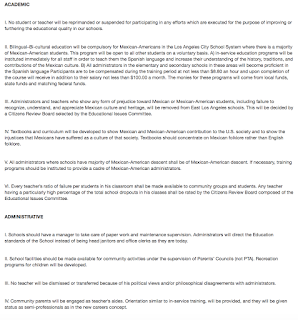It Doesn't Matter If You're Black or White or LATINO
"The contradictions, hypocrisies and lies of the history of the nation provoked a certain anger. There was the obvious social injustice of living in the country as Chicanos and Mexicanos, all being programmed to become laborers. None of us were being programmed to enter college. There was a realization that the drop-out rate was not our own failure, but that of the system which preprogrammed us. The failure on our part was we bought into it, and we accepted that was all we could do"
-Moctesuma Esparza
A healthy and well nourished upbringing during early childhood is crucial to positively developing the future adults and leaders of the nation. The inequities seen in the East Los Angeles School Districts in the dawn of the Civil Rights era of the 1960s emphasized the need for change. Much of the Civil Rights battle up to this time has been seen from and black and white lens, failing to capture the injustices to Latinos (especially in urban locations). In trying to obtain "The American Dream", Chicanos in Los Angeles faced many obstacles and setbacks, primarily due to their treatments from the government and unwilling individuals (as illustrated by Esparza).
High schools in East Los Angeles lacked funding and were usually overcrowded. This was devastating to these primarily-latino communities and their chance at a more bountiful future. At the same time, Latinos were receiving harsh punishments and maltreatment from school staff and superintendents. As a result of the poor educational conditions and the fact that numerous attempts to voice community concerns and school reforms were ignored, school strikes took place during the first week of March 1968. After the movement grew mainstream, student leaders, activists and community officials drafted a list of demands from the East LA School Districts including more schools, less cruel punishments and overall better school conditions.
In the list drafted, Chicanos demanded that "Textbooks and curriculum will be developed to show Mexican and Mexican-American contribution to the U.S. society and to show the injustices that Mexicans have suffered as a culture of that society". This captures the significance of the movement eloquently; the group was tired of feeling oppressed and as if their culture didn't matter. They wanted the public to see the value to society that Chicanos add. Though the movement continues today (as seen through movements like Chicago Public School Walkouts in previous years), Chicanos demonstrated great resilience and were able to combine peaceful protest with precise organization to gain more permanence and attract hopeful attention to their demands as main contributors to the country.

This brings to light sevral important issues but primarly the effects of one particular commuity being marginalized while the lack of effectiveness of the public school system. In your opnion what all can be be done to public schooling system ??
ReplyDeletedone to improve the ^^^ (typo correction)
DeleteAye Myat Mon
ReplyDeleteYou are so correct about the fact that for many, the Civil Rights battle in America is seen from a black and white lens. The problems and injustices towards Latinos, as well as other minorities, deserve to be acknowledged too. What other injustices do the Latino community face ?
I think your point about the importance of schools children's development is very pertinent. For example, the simple demand that textbook portray Mexican historical figures is really very important to helping children be proud of their cultrual identity.
ReplyDelete